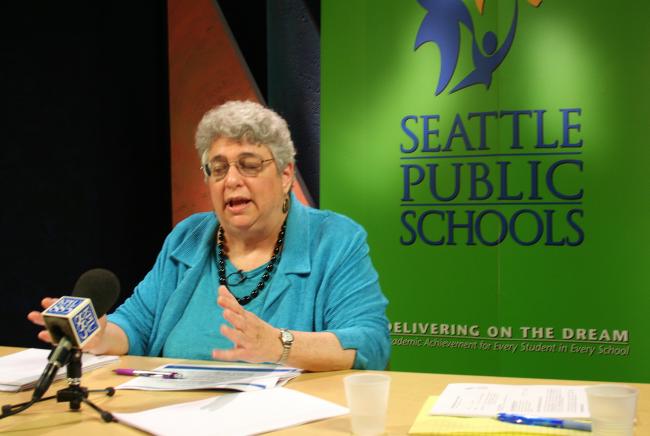More details of new student assignment plan explained
Tracy Libros, Seattle Public Schools enrollment and planning manager, describes details of the district's proposal for a new Student Assignment Plan.
Tue, 06/02/2009
Since the Student Assignment Plan Part I was introduced by Superintendent Maria Goodloe-Johnson, new details have been made regarding the choices parents will have regarding where they send their children.
Tracy Libros, Seattle Public Schools enrollment and planning manager, met with media on June 2 to discuss details of the plan. She explained that district staff have designed the new Student Assignment Plan to be much easier to understand and accessible to families.
“We’re going for clarity or simplicity,” said Libros.
The biggest change parents will see compared to the current plan is that their students will start with a predictable assignment to a local school based on their address. Each elementary school will have a specific reference area and groups of those schools will filter into middle schools and, later, high schools.
To ensure that all students have equal access to special services, middle school attendance areas will also become service areas. The district aims to offer all basic services in each of these areas and Libros ensures that all students with special needs will have access, including transportation, to the services they need.
“If there’s only one place that meets the child’s needs then they would be assigned there,” said Libros. “But the idea is to bring services to children rather than bring children to the services.”
Parents will have the option of sending their children to schools outside their reference area through a standard choice process. Instead of the numerous tiebreakers that currently exist, there will only be a sibling tiebreaker, followed by a random lottery.
With the sibling tiebreaker, when the plan is first implemented, parents with an older child in a school outside their reference area may not be able to get a younger child entering kindergarten in the same school. Over time, siblings may not be guaranteed placement in the same school unless they attend their reference area school.
However, Libros pointed out that parents will have the opportunity to select an option indicating that it is most important for their children to attend the same school, and their children will be guaranteed a spot at a school together.
There will be no sibling tiebreaker for programs that require qualification, such as APP and Spectrum, however parents will have the option of sending their other children to general education programs at the same school as these programs.
A public hearing will be held on June 10, in which members of the public can comment on this portion of the Student Assignment Plan. The following week, on June 17, the board will approve or reject the plan.
Following that action, Student Assignment Plan Part II will focus on drawing new boundaries and school reference areas.
As Libros pointed out, these boundaries have not been updated in decades while the city has seen significant demographic changes.
Initial implementation is scheduled to begin during the 2010-2011 school year.
It will be a staggered process, and initially entry level students may be the only ones guaranteed a spot in their reference area school. Certainly, parents with children in other grade levels will have difficult decisions to make when determining whether their children will stay together in the same school.
The framework for a new Student Assignment Plan was approved by the Seattle School Board in June 2007.
The Public Hearing will be held on June 10, 6 p.m. to 8 p.m. at the John Stanford Center for Educational Excellence, 2445 3rd Ave. S.
The School Board will take action on Part I of the plan on June 17, 6 p.m. to 9 p.m. at the John Stanford Center for Educational Excellence, 2445 3rd Ave. S.


